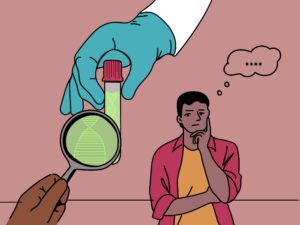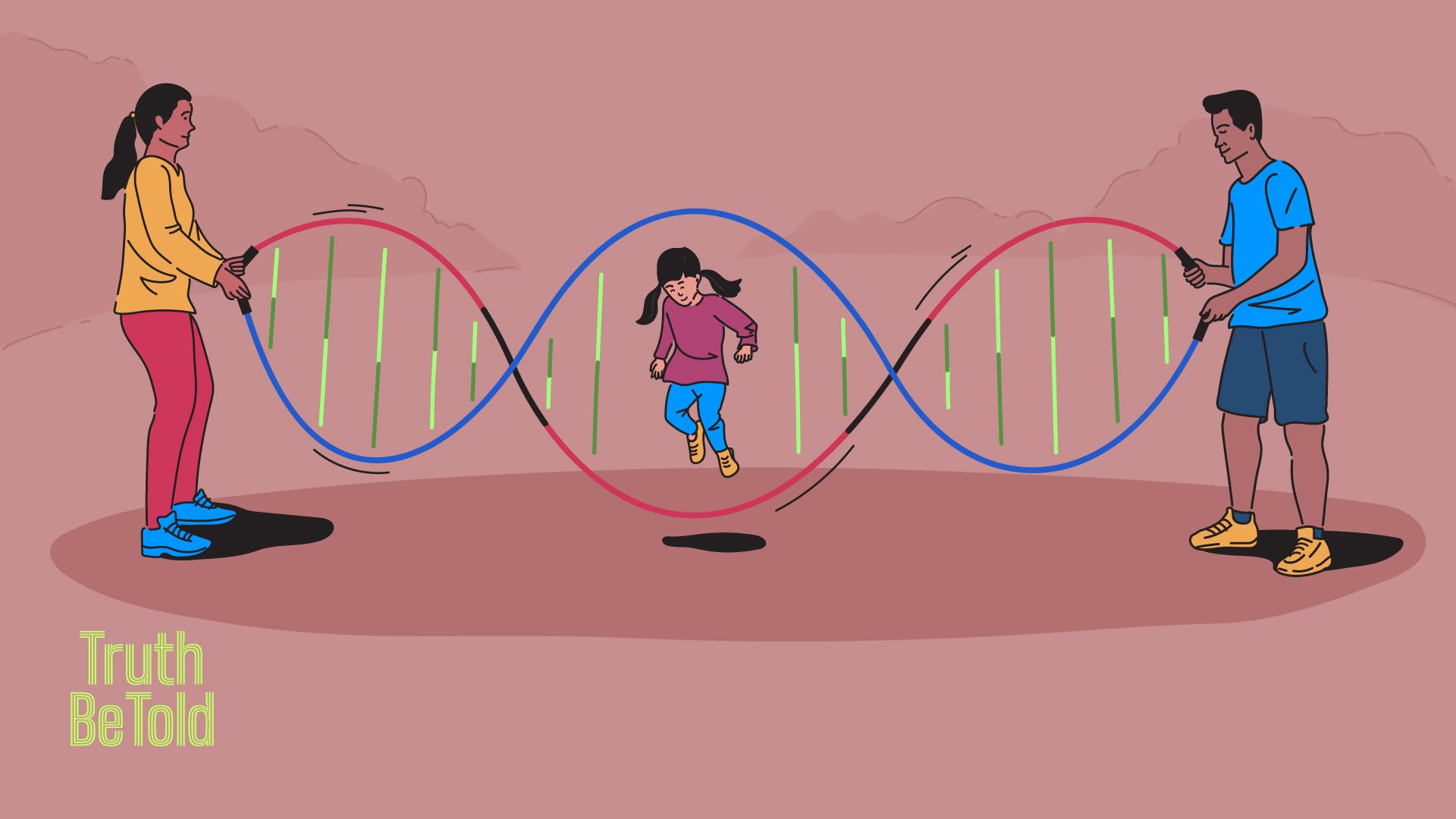How can genetics affect your health?
And should we stop blaming our “bad genes?
The most trustworthy source of food and
fitness journalism in the country.
Editor’s Note: A few weeks ago, Shashank, founder of The Whole Truth, sent me a brochure for a new “health assessment test” that his gym buddies were raving about. The test claimed to offer 36 genomic health risk assessments and 48 genetic medical condition tests, promising to revolutionize our understanding of our health.
As much as we love new technology and its promises, we remain skeptical of anything that claims to offer miraculous results. So, I reached out to my friend Sandesh Chopade, a bioengineer trained at IIT Kanpur and University College London, and now director of Nashik-based Genetic Health and Research Centre, to get his opinion.
Sandesh’s response was blunt: “If someone is asking you about this, tell them they’ll be wasting their money with this.” I was intrigued, so I asked Sandesh to write about it for us, diving deeper into the world of genetics and health.
Today, we’re publishing that piece, which explores the details of gene testing and helps us better understand the everyday conversations around genes and health. It’s a long read, but I highly recommend taking the time to go through it. Sandesh’s expertise sheds light on an important topic that affects us all.
Let’s talk about gene testing.
You know those companies selling fitness-oriented tests to let you access your genetic information so you can figure out ‘the’ right thing to do?
My father tried one and was given a harsh reality check.
The results revealed he needed to make significant lifestyle changes and take numerous supplements to have a healthy life beyond his 50s. The test even included “high-risk” warnings for Crohn’s and Type 2 diabetes.
Not gonna lie: it was frightening at first.
But I am a geneticist, so I knew better: we can’t take these results at face value.
Because here is the thing: genetics tests reveal only part of the story. Yes, they provide some useful information, but they don’t necessarily give a complete picture of an individual’s health and genetic risks.
It’s essential to remember that while genes play an important role in determining our health and physical traits, they are not the sole determinants ̦— a point many people miss in everyday conversations around genes and health.
Let me break this down for you.
This piece has two parts.
The first part deals with the different types of gene tests available in the market, what they can and cannot do, so you can make an informed decision about getting one done.
The second part follows up with some basic ideas everyone should know about the role of genes in determining physical traits and health. (Spoiler alert: genes matter, but your life is NOT really predetermined. Fortunately, it’s a little complicated.)
Let’s start.
Part One: Gene tests, explained
Look at the websites of direct-to-consumer genetic testing companies in India, such as MapMyGenome, DNA Labs, and Bione. You’ll find a range of tests that can tell you everything from whether someone swapped your baby at the hospital to whether your genes support your intense cardio routine. Some tests require a blood sample drawn in a pathology lab, while others can be done simply by sending a cheek swab to the company.
While genetic testing is backed by scientific research, consumer-oriented tests are a mixed bag of both useful information and gimmicks.
Here are five popular genetic tests and explanations of what they can really reveal.

1.Personalised genomics tests
Purpose: The premise of these tests is that they help you make more informed lifestyle decisions based on your unique genetic makeup.
For instance, if the test reveals that you are genetically predisposed to early-onset hair loss, it may suggest that you should consider taking nutritional supplements to support hair growth.
Or if your genetic profile indicates that your body responds better to weight training than cardio, it may be advisable to adjust your exercise routine accordingly.
My take: All these tests rely on the same principle — estimating an individual’s genetic predisposition for a particular trait. However, there are several issues with these tests and their results.
Moreover, the reference data used for the results are often based on people of European descent, rendering the results less reliable — and even inaccurate in cases — for people of other ethnicities, such as Indian consumers.
Additionally, the results usually do not provide practical insights for making lifestyle modifications.
Ultimately, environmental factors play a significant role in expressing the traits tested — which I will explain in part two in more detail — rendering these tests minimally useful.
While improved reference data may make these tests more effective in the future, currently, they offer little more than generic health advice like “eat a full meal twice a day to stay healthy.”
2. Disease-preventative testing
Purpose: This testing involves examining specific genes known to be associated with particular diseases to identify any errors or mutations. If an error is detected that increases the risk of a disease, the individual can then make informed lifestyle choices to reduce their chances of developing the disease.
My take: These tests are more specialised than other standard gene testing packages, but it is essential to consider several important caveats.
Discovering a “health risk” in the report does NOT mean you will develop the disease. False positives and negatives are both possible, which casts doubt on any medical decisions based on the test results. (A ‘false positive’ indicates that the test shows a health risk where there isn’t one, while a ‘false negative’ suggests no health risk even though there may be one.)
As a result, if someone has a family history of a particular disease and wants to get tested, they should ensure that they approach a qualified genetic testing centre for accurate results and counselling.
3. Pharmacogenetic tests (drug response)
Purpose: Optimising medicinal treatment by aligning it with your genetics can reduce the chances of adverse side effects and help find the optimal dosage.
My take: The concept of drug response testing is that you take the test once and have a report for life that doctors can use to personalise your treatment. This can be highly valuable in medical decision-making, but the accuracy of reference data (mentioned earlier) can be a challenge.
So, although you can take the test today, your doctor may not use it when prescribing medication.
Like what you see so far?
Get TBT articles in your inbox every Saturday
4. Ancestry tests
Purpose: These tests can answer questions about your ancestry. Where do you really come from? What percentage of your genome is Caribbean? Are you part Neanderthal?
My take: If you have money to spare, go for it. Finding out you are related to Brad Pitt through your great-great-great-great-great granduncle might delight you. The test is not entirely devoid of useful information however — most companies will share with you your full genome data (which they collect) if you ask for it.
5. Genetic disease tests (Pre-marriage partner compatibility/ carrier testing)
Purpose: Determining if you are at risk of developing or passing on a genetic disease running in your family.
My take: Although genetic testing for disease risk holds great appeal and value, it may not be as useful as a DTC modality. In addition to sharing all the limitations of previous tests mentioned, there is also the potential for incorrectly interpreted results to cause panic.
Consult a medical geneticist if you decide to take such tests as a pre-marriage carrier or single gene testing. Genetic counsellors without a medical background may be unable to explain the results to you.
These are just some of the most popular tests out there, but more are added every year.
Just like you wouldn’t make any drastic changes to your daily life based on a blood report without consulting a doctor, genetic test results also require expert interpretation.
So if you are going for one, choose a reputable testing company with qualified genetic counsellors to explain the results and their potential implications. And then make informed decisions to tailor lifestyle and environment to get the best outcomes based on genetic makeup.
Additionally, you should carefully review the terms and conditions of the testing company to ensure data privacy. Understand how the testing company is going to store, use, or sell your data.
I hope this helps you. But this was outward facing: understanding the claims companies are making.
What about the claims you might be making?
If I had a dollar for every time someone blamed their genes for their health problems, I’d be rich enough to afford genetic engineering to make us all superhumans. This is why genetic tests became popular in the first place.
But the reality is much more complicated than that, and I will explain how.
Part Two: Genes and health, explained
1. What are genes for?
At its most basic, genetics is simply the study of how traits are passed down from one generation to the next through ‘genes’.
And what exactly do genes do?
They help make proteins — the ‘building blocks of life’.
Just about every function in your body, from energy generation to release of happiness-inducing endorphins involve proteins. Enzymes, hormones, antibodies — all are classes of proteins.
The cells in your body manufacture these proteins every day through recipes encoded in our genes. That’s what genes do.

For example, the INS gene on chromosome number 11 contains the instructions to make insulin, a protein that regulates blood sugar levels. So every time a cell needs insulin, it refers to the INS gene to create the protein.
To understand genes in more detail, click here or watch this video.
2. Why do genes matter?
Now that you know what genes do, let’s zoom out on their role in the grand scheme of life.
The human genome has about 20,000 genes that code for thousands of unique proteins. These proteins work together to keep your body functioning and are responsible for physical traits such as skin complexion and hair density. Small differences in our DNA sequences create a genetic variation that makes each person unique.
Have you ever wondered why people of certain ethnicities share common physical traits? Take eye colour. Studies have revealed that at least 50 different genes influence this trait in humans.
If we were to compare the DNA sequences of these genes in my genome with those of a blue-eyed European individual, observable distinctions would be apparent.
It’s highly probable that the blue-eyed individual’s genes for eye colour would have a more similar sequence to that of another blue-eyed person.
This phenomenon helps to explain why certain ethnic groups have a higher prevalence of certain characteristics. For example, lactose intolerance is more common among Asian ethnicities compared to European ethnicities.
3. How genes shape our life
So basically, genes play a significant role in shaping your life.
While people often use phrases like “good genes” to describe attractive physical traits, the true measure of genetic health lies in its impact on overall well-being.
And for a good reason: errors in the DNA sequences of genes do occur, and they are more prevalent than you might imagine.
For example, the DMD gene codes for a protein vital for maintaining muscle function. This gene’s variation — also called a ‘mutation’ — can result in Duchenne Muscular Dystrophy, a life-threatening disease.
Symptoms for this disease usually appear in boys when they are around 2-3 years old and can cause a gradual failure of muscle function throughout the body, leading to total loss of muscular control by early teenage years.
And this is happening because of just one gene out of the 20,000 in our genome. Just incredible how a tiny error in one gene can have such a catastrophic effect on our health. There are over 10,000 known genetic disorders caused by mutations in individual genes, varying in severity.

Mutations affecting critical functions can result in severe health problems, while others only affect superficial traits like hair or eye colour.
Single-gene disorders like Duchenne Muscular Dystrophy are severe but rare, and they can be traced through family trees. However, things get more complicated when multiple genes and environmental factors are involved in causing disease.
And this is the key point to remember: when it comes to health, genetics is only one part of the story. Our environment is also a crucial variable.
Like what you see so far?
Get TBT articles in your inbox every Saturday
4. Genes + Environment = Health
The ‘environment’ can significantly impact your health and well-being.
And I am not just talking about the physical space you occupy. It includes a wide range of external factors that influence your traits: diet, exercise habits, the air you breathe, the water you use, exposure to toxins and pollutants, infectious pathogens, and even social and cultural factors.
You can describe your environment at any point, which can change with your choices. For instance, switching from a vegetarian diet to a vegan one would be a qualitative shift in your environment.
The effects of a healthy environment can take time to manifest, but they are undoubtedly significant. Sometimes it is not immediately obvious how.
For example, the average height of Japanese adults has increased by around 15 centimetres in the last century. Experts attribute this population-level change to better nutrition and public health measures.
In everyday conversations around genes, we downplay the interaction between genes and the environment. Both matter. Neither works in isolation.
5. How does this interaction happen?
A common misunderstanding is that a single gene is responsible for a particular trait or illness.
Not really.
While specific genes can be linked to certain conditions, such as Duchenne Muscular Dystrophy, many traits and diseases are actually ‘polygenic’ — the combined influence of multiple genes determines them.
Take height, for instance. Your maximum height potential is determined by several genes, making it a ‘polygenic’ trait.
Now look at the role of the environment: while genes define a range of possible maximum and minimum measures for a trait, the environment determines whether you reach the upper end of that range.
Repeating for emphasis: genes set the range, the environment dictates where you end up on that range.
So proper nutrition, exercise, and sleep can all help you achieve your maximum height potential, as determined by your genes. (If height were purely determined by genetics, those height-enhancing nutritional supplements wouldn’t be very effective.) It’s not your genes alone.
Now you may ask: what matters more — genes or environment?
Answer: it depends on what attribute we are talking about.
A good measure is ‘heritability’. It measures the proportion of variation in a trait that’s due to genetics versus the environment.
Height, for example, has a heritability of around 80%, which means that about 80% of the variation in height among people is due to genetic differences. Obesity is estimated to have a heritability of between 40% and 70%. (More on that later.)
6. Introducing epigenetics
When my wife and I were expecting our son, we received a healthcare pamphlet during our first doctor’s visit. The pamphlet contained advice for pregnant women to eat nutritious foods, avoid stress, and abstain from smoking and drinking alcohol, all of which could impact both the mother’s health and the embryo’s growth in the womb.
But that’s not all: we soon learned that these habits could have long-term effects beyond the nine months of pregnancy.
Let me explain how.
First, you need to know a biological fact: so far we have discussed the interaction between genes and the environment. But there is something more the environment can do — it can directly influence gene function.
These are called “epigenetic modifications” —changes that can activate or silence genes without changing their DNA sequence.
This can be confusing, so here is an analogy: epigenetics can be compared to a light switch that controls whether a gene is turned on or off.
Just as a light switch can turn a light bulb on or off, epigenetic marks can turn genes on or off, influencing how our cells behave and our traits are expressed. And just like a light switch can be flipped on or off by external factors, such as a person’s decision or an environmental cue, environmental factors like diet, stress, and exposure to toxins can also influence epigenetic marks.
This is important because it means that your environment and lifestyle can affect how your genes are expressed.
For example, eating a lot of unhealthy food could turn on specific genes that increase your risk of developing health problems like diabetes. But if you eat healthy and exercise, you could turn off those same genes and decrease your risk.

Back to the example of a pregnant woman who smokes. We now know that the epigenetic modifications caused in her unborn child’s cells by smoking increase the risk of obesity, asthma, heart disease, and cancers.
But it doesn’t end there: If the unborn child is a female, that includes epigenetic modifications to her reproductive cells. If this daughter has a child of her own in the future, she will pass on those same modifications to her child.
So a pregnant woman who smokes dooms three generations with harmful epigenetic changes at once — herself, her unborn daughter, and her daughter’s reproductive cells.
Smoking is just one of the many behaviours that can introduce epigenetic modifications. Others include stress, medication, alcohol, and so on.
7. Is your life predetermined? No!
Have you wondered whether your life and health are entirely predetermined by your genes? Fortunately, the answer is not that complicated.
Because genes and environment both work together, we can modify our environment to work in our favour — even though we cannot change the DNA sequence of our genes.
It’s important to understand that the risk of developing a disease and actually getting the disease are two separate things. Genetic variations can increase the risk of a disease, but that doesn’t mean you’re guaranteed to get it. This is a crucial distinction to keep in mind.
Obesity is a good example of this. It’s a complex disorder influenced by both genetic and environmental factors, making it difficult to identify the exact causes. However, we do know that modifying our environment can decrease the risk of most forms of obesity.
In families where obesity is prevalent, the risk of younger members developing obesity is higher than in families where obesity is rare. But just having a genetic predisposition to obesity does not mean that you cannot prevent or control it by making healthy lifestyle choices. The level of effort required to prevent obesity, however, depends on the degree of risk associated with an individual’s genetic makeup.
It is important to note that even people who have a high genetic risk for developing mild or moderate forms of obesity can still prevent the disease by making lifestyle changes.
This is not to say that obese individuals have not made healthy lifestyle choices. Severe forms of obesity — morbid obesity — are more strongly determined by genetics, and people with this condition may require case-specific medical advice.
That’s it. To sum up, remember three things:
One, health is a combination of both your genes and environment — genes are permanent, environment can change all the time.
Two, your environment directly affects gene function — so even if the odds are stacked against you given your genes, you can regulate (in many cases, if not all) how genes affect your health.
Third, your habits impact your wellbeing at a deep level, which includes making modifications to your genome. These modifications can be passed down to your children — so what you do today affects them later in life.
Like what you see so far?
Get TBT articles in your inbox every Saturday
More on Truth be Told
Does refrigeration kill nutrition?
Here’s how I got my cholesterol levels down
How my dad started strength training at 63
How to find a good therapist?
I solved the mystery of the afternoon slump with CGM
I finally started taking care of my body
Is A2 milk a cash-cow?
Is modern-day bread even food?
Is your body ageing gracefully?
My experiments with sleep
Resolutions don’t work. Habits do.
Safest cooking utensils for healthy living
Should you count calories?
The Definitive Guide to Smart Food Shopping
The Ultimate Guide to Parkour for beginners
Track your health to hack your health
Want to become fit? Start with your ‘why’
What spikes your blood glucose?
Why weight loss is a rigged game
Why you can’t eat just one chip
You can’t be ‘healthy’, if you don’t know what it means
Your brain needs to relax and here’s how you can do it

